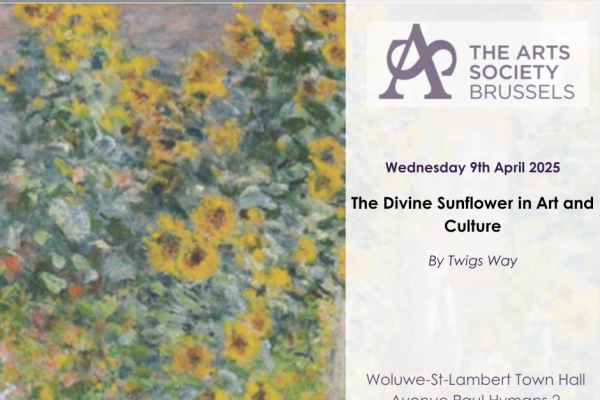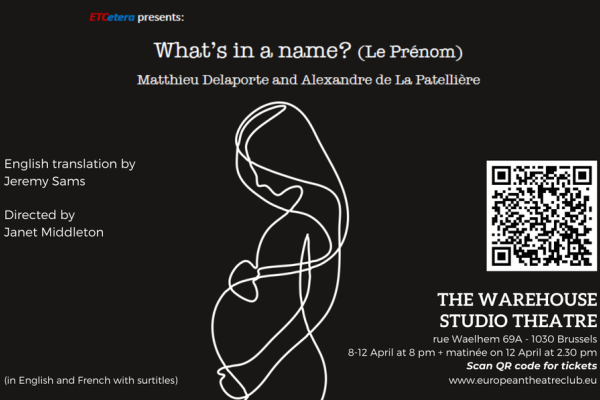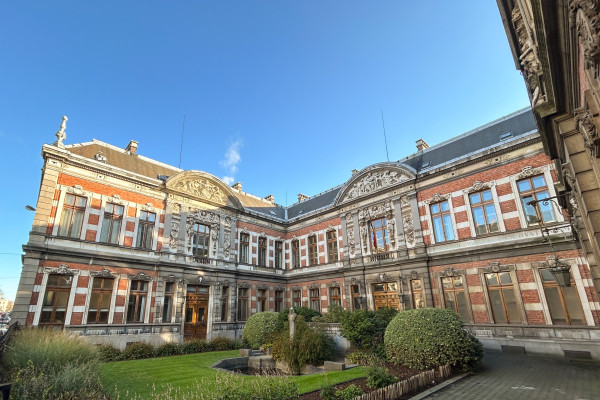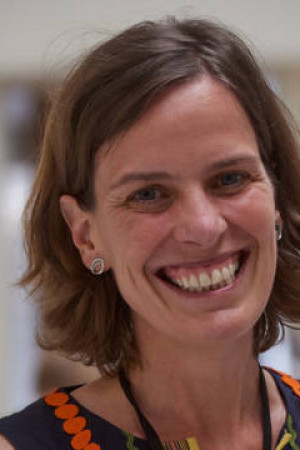
Peggy Guggenheim (1898–1979), niece of Solomon R. Guggenheim, founder of New York’s Guggenheim Museum, deserves much of the credit for spreading “the religion” of modern art across oceans. She was a colourful character, a self-described “art addict” who made her mark on the world through collecting art works from Vasily Kandinsky to Jackson Pollock to Yves Tanguy, Marcel Duchamp and countless others. Her private life was as passionate and colourful as her collecting. While fighting through personal tragedy, she maintained her vision to build one of the most important collections of modern art, now enshrined in her Venetian palazzo.
Our speaker Isabel Vermote is an Historian and Art Historian. She studied at the universities of Namur, Leuven and Brussels. She currently works for the Education Department of the Royal Museum of Fine Arts of Belgium and is also a lecturer at the Bozar, ING, Belfius and for some private collections.

Some background to the talk on April 20 about:
PEGGY GUGGENHEIM - ART COLLECTOR AND GALLERIST
Born: August 26, 1898 - New York - Died: December 23, 1979 - Venice, Italy
Movements and Styles: Surrealism, Abstract Expressionism, Modernism and Modern Art
Early Life: 1920-37
Financially independent due to the inheritance she received when she turned 21, Guggenheim was able to continue her search for a different lifestyle. In 1920, she began working as an unpaid assistant at Sunwise Turn, a midtown Manhattan avant-garde bookstore. Mary Horgan Mowbray-Clarke, the wife of the sculptor John Frederick Mowbray-Clark who had helped organize the 1913 Armory Show, and Madge Jenison, a noted author and activist, cofounded the bookshop, one of the first woman-owned bookstores in the country. The bookstore was a hub for avant-garde literature and socialist ideals and also featured small art exhibitions of emerging artists. As Harold Loeb, the art critic and Peggy's cousin wrote, "Coming under Mary Clarke's spell Peggy gradually discarded many traditional taboos and adopted a whole set of new ones. Feeling guilty, no doubt, for having inherited wealth, she came to deny herself some of the luxuries to which she was accustomed. In compensation she collected the latest in experimental painting and gave money and meals to poor artists and writers."
Guggenheim Jeune: 1938-39
Guggenheim began thinking of starting a publishing company or an art gallery, and with the inheritance she received after her mother's death in 1937, she opened the Guggenheim Jeune gallery in London in 1938. Aided by Duchamp, as she said, "he arranged all my exhibitions, did everything for me," the gallery's first show featured 30 of Jean Cocteau's drawings. The gallery held Kandinsky's first solo exhibition in Britain, exhibited the works of Wolfgang Paalen and Yves Tanguy, and held group exhibitions of sculpture and collage, featuring Henry Moore, Alexander Calder, Jean Arp, Pablo Picasso, Georges Braque, Raymond Duchamp-Villon, Kurt Schwitters, and Constantin Brancusi. Guggenheim began her practice of purchasing at least one artwork from each exhibition, building her own collection. The first work she bought was Jean Arp's Shell and Head (1933) of which she said, "I fell so in love with it. The instant I felt it I wanted to own it." She also freely explored her own sexuality, having hundreds of affairs and brief encounters, with artists like Tanguy and writers like Samuel Beckett. At the same time, as art historian Donald Kuspit said, "Art gave a meaning to her life....the Modern, the avant-garde artists confirmed her sense of being, in some peculiar way, an outsider. Art became her way of finding herself emotionally."
Art of This Century Gallery, 1942
Cultural critic Carlo McCormick described the New York art scene in the early 1940s as a "small kind of gentleman's club and the story was that you could fit the given art world into a small room in New York." At the same time, that world was changing as many European artists immigrated to New York, fleeing World War II and Nazi Germany. In 1942, Guggenheim opened her Art of This Century Gallery, with sections devoted to Surrealism, Kinetic art, Cubist, and abstract art; as art historian Dore Ashton noted, her "gallery was one of the first international galleries in New York City mixing American and European art." Anton Gill described how, at the gallery's premier, Guggenheim wore, "one earring made for her by Calder and another by Yves Tanguy, to express her equal commitment to the schools of art she supported."
Frederick Kiesler designed the innovative gallery to create a totally modern experience; some paintings were hung on universal joints, which allowed viewers to turn the paintings to experience different angles of light, thus, creating a more intimate relationship between the viewer and the work. He created an unusual lighting design that occasionally plunged an entire gallery into darkness, and his furniture acted both as seats for gallery-goers as well as easels for paintings.
Through her trusty advisor Howard Putzel, Guggenheim began discovering American artists. She became an early patron of Jackson Pollock, providing him with a monthly stipend, his first commission, and his first exhibition. As the art critic Clement Greenberg wrote, she gave "first showings to more serious new artists than anyone else in the country," and as the artist Lee Krasner wrote, "'Art of this Century' was of the utmost importance as the first place where The New York School could be seen, her gallery was the foundation, it's where it all started to happen." With her 1942 Exhibition by 31 Women Guggenheim also held the first exhibition solely devoted to women artists, though it had unexpected personal consequences. One of the artists was Dorothea Tanning with whom Max Ernst fell in love, leading to his divorce from Guggenheim in 1946, an event of which Guggenheim said, in her characteristic ironic way, "I should have had 30 women. That was my mistake."
Venice: 1947-1979
In 1946 Guggenheim published Out of This Century: Confessions of an Art Addict, her autobiography that created something of a scandal due to her honest and revealing recount of hundreds of affairs and sexual encounters she had had with various writers and artists. Her family was dismayed, as her wealthy uncles tried unsuccessfully to buy up all the copies, and critical response was equally dismissive. The Chicago Tribune caustically wrote that it should have been titled, "Out of My Head." Wanting a fresh start, she closed her gallery in 1947 and moved to Venice, which she called "the city of her dreams." In 1948, the Venice Biennale invited her to exhibit her collection, which marked the first time the works of Pollock, Mark Rothko, and other American artists had been seen in Europe. She subsequently bought the Palazzo Venier dei Leoni, an unfinished 18th-century building on the Grand Canal, where she resided for the rest of her life.
In Venice, she became a celebrity, known for her butterfly sunglasses, designed by Edward Melcarth, which she wore everywhere as she navigated the city in her private gondola and her accompanying dogs. Her home was a hub for visiting writers and artists, and she also promoted the works of emerging Italian artists like Marini. In 1951, she opened her home as a museum to the public, and in the subsequent decades, she also loaned her collection to various museums in Europe and the United States. As a result, as art curator Jeffrey Deitch noted, "Peggy Guggenheim was one of the links between European and American modernism. Between surrealism and abstract expressionism." Despite her successful life as a collector and though she had a number of liaisons with young Italian men, she was frequently lonely, writing in a letter, "God forbid my ever getting too attached again in my life to anyone. So far everyone I loved has died or made me madly unhappy by living. Life seems to be one endless round of miseries. I would not be born again if I had the chance." Guggenheim continued collecting art until about 1973, and in 1962 Venice bestowed upon her an Honorary Citizenship. She died in 1979, and her ashes remain on the grounds of the Venetian palazzo that houses her collection.
The Legacy of Peggy Guggenheim
Guggenheim returned to New York in 1969 when the Solomon R. Guggenheim Museum, founded by her uncle, invited her to show her collection. She said of the occasion, "I was thunderstruck, the entire art movement had become an enormous business venture. Only a few persons really care for paintings." Her model, emphasizing patronage for avant-garde artists and advocacy for their work, provided an alternative to a market-driven art world. She said, "I am not an art collector. I am a museum." In 1970, she donated the Palazzo Venier dei Leoni to the Solomon R. Guggenheim museum, followed by the 1976 donation of her collection with the proviso it would remain in Venice.
As art critic Allison McNearney wrote of the Peggy Guggenheim collection, "It is not only one of the premier collections of modern art in the world, featuring over 300 works by over 100 of the most influential artists of the 20th-century, but it also has played an integral role in turning Venice into a mecca for contemporary art." Her showing at the Venice Biennale influenced the rise and prominence of the international exhibition, and today the Palazzo Venier dei Leoni permanently houses the U.S. Pavilion of the Venice Biennale. Additionally, it is also the most visited Italian museum of modern art and the second most visited museum in Venice.
Article courtesy of The Art Story, Founder - Michael Zurakhinsky.
Very often brilliant academics explain art solely to other brilliant academics, not to the world at large. Volumes are written that can only be accessed and interpreted by the few.
The Solution: Birth of The Art Story
We believe in a world where the ideas and aspirations behind wondrous art works are accessible to everyone to explore and be inspired by. TheArtStory.org helps millions of people each year understand and enjoy every style of art, from Classical Greek statues, to Dali’s Surrealist concoctions, to Contemporary Conceptual explorations.
Note: Content and images not intended for copyright infringement.

On 15 September our International Study Group gathered for the first time after a long confinement. For months, we have not seen each other, have heard little from another. We did not have our social lunches and even our traditional Summer Lunch was cancelled. All of this was because of the Covid-19 pandemic.
Finally, we've met in the elegant rooms of the Château Sainte-Anne to hear a lecture about Peggy Guggenheim, an icon of modern art, presented by Isabel Vermote, an art historian who works at the Royal Museum of Fine Arts of Belgium.
I don’t know the reason, was it a desire to be together at last and forget about the plague in our midst or was it the subject of the lecture or perhaps the splendid weather, but the atmosphere of the gathering was splendid. This was so starting from the first minutes when we joined each other on a sunny terrace facing the marvellous green grounds of the Château Sainte-Anne.
Then came the lecture.
On the screen we watched a sequence of photos of Peggy, of the works she collected, of portraits of famed artists, many of whom were her lovers, her husbands. Pictures of New York and Paris were replaced by shots of London and Venice, the places where Peggy lived her life. In New York she was born and grew up. At the age of 21 she received an inheritance amounting to several million dollars and moved to Paris hoping to become an artist. Undoubtedly, in the 1920s Paris was the cultural capital of the world, where every aspiring artist flocked. But Peggy quickly understood that she did not have enough talent. Having the financial means, she ventured into art collecting. Later on, in her memoirs she called herself an avid collector. Art became her life.

Living in Paris, being surrounded by artists and art specialists, her knowledge of art grew. She had a rare talent: she recognized her mistakes, learned from them and moved on. By the end of her life she had accumulated a few hundred works of art. She bought things which at that time people found strange or peculiar, and which since have become the backbone of 20th century art. If we look at her collection, it seems to be an encyclopaedia of the art of that century with works from Marc Chagall, Wassily Kandinsky, Constantin Brancusi, René Magritte, André Breton, Paul Delvaux, Joan Miro, Marcel Duchamp, Mark Rothko, Francis Bacon, Yves Tanguy, Alberto Giacometti, Max Ernst, Jackson Pollock, Fernand Léger, Salvador Dali, Alexander Calder and many others.
Her life, her outings, her statements, her romances, her dresses were popular subjects of the tabloid press. She enjoyed the attention. When the war started, she was in Paris, as were many artists, who found themselves in a difficult financial situation. Peggy had an unlimited choice of art. Between 1939 and 1941 she was buying “a painting a day”. She said that it was her motto and she lived up to that whenever she could. She paid a thousand dollars per painting and the field was hers. But underneath the appearances there was hard work.
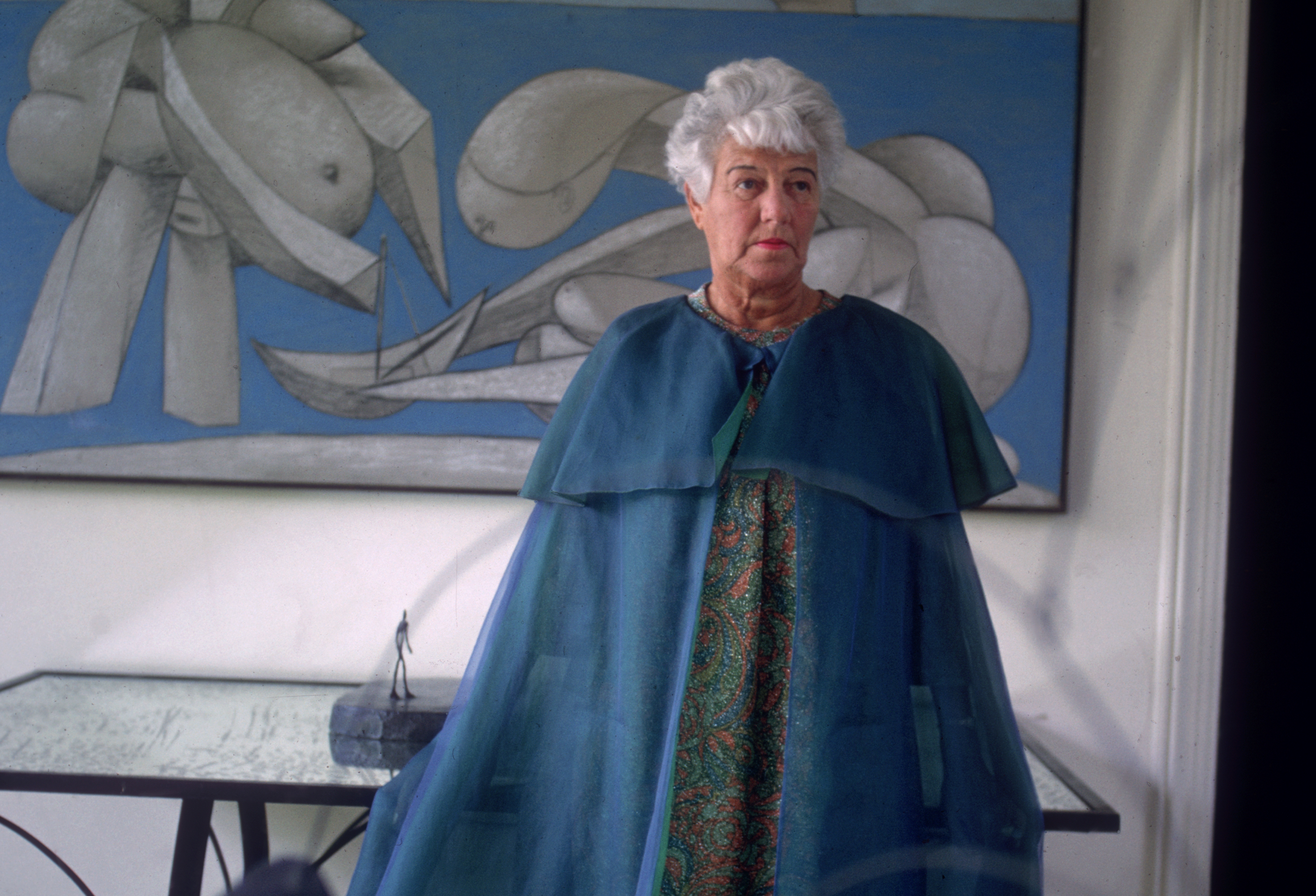
If you take into account the time to choose, to decide, to determine the perspective of the piece, to define more correctly its potential, you will realize the complexity of the profession. Peggy once said: “A collection means hard work. It was what I wanted to do, and I made it my life. I am not an art collector. I am a museum.”
Peggy Guggenheim was irresistible, charming, rich, clever, with a great gift of persuasion, rare intuition, insight for great art, a talent to assemble around herself great artists. She also had an unusual zest for life in all its manifestations.
After Paris she moved to London, then back to New York which she found had changed for the better. She liked it and decided to launch her gallery over there. In 1942 ‘The Gallery of Modern Art’ was opened. Peggy wrote about the opening of this gallery: “Opening of the ‘Gallery of Art of this Century’ when people are fighting for their lives and freedom serves its purpose only if it succeeds in serving the future instead of recording the past.” This step of hers can serve as an example of her eccentricity and conviction that she was correct in her judgement. The gallery was a success and existed for several years.
Finally, in 1947 Peggy settled in Venice where she stayed for 30 years. Venice was her last destination, her eternal love. She said once, “What a silly idea to come to Venice for a honeymoon. Venice is the place which leaves no room for another love. You fall in love with the city and nothing else or nobody else.” She lived in the Venetian Palazzo Venier dei Leoni and called herself the last Dogaressa or the Queen of Modern Art.
That same year she participated in the Venetian Biennale of Art, exhibiting her own collection in the Greek pavilion. That was how she started thinking about herself as a museum. Usually the pavilions are allocated by countries to their artists and not to collectors. In 1949 her palace became ‘The Museum of Modern Art’ while she continued living there. The public was permitted to visit it on certain days and at certain hours together with the sculpture garden. The Palazzo Venier dei Leoni has become one of the most popular museums of modern art in the world, welcoming 400.000 visitors annually. It is the most visited museum of Venice.
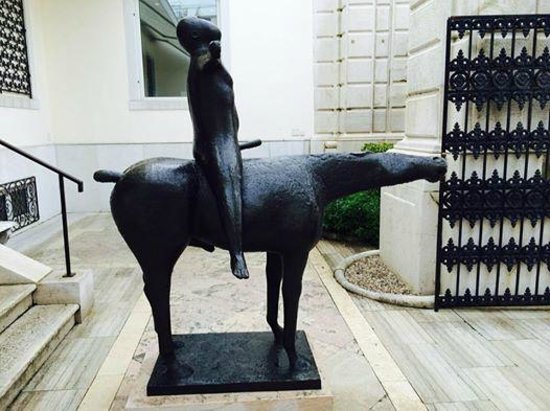
Peggy loved Venice and Venice loved her. In 1962 she became an honorary citizen of the city. She was the only one who was permitted to own her private gondola. She died near Venice in 1979 and is buried in the garden of her palace on the banks of the Grand Canal next to her favourite dogs.
On the steps of the staircase leading to the entrance to the Peggy Guggenheim museum ‘The Angel of the City,’ a sculpture by Marino Mariini welcomes visitors. A naked man sits on a horse back, his phallus in full strength. This is another example of Peggy’s eccentricity and desire to provoke people.
Isabel gave us a persuasive portrait of the irresistible personality of this woman who created for herself a colourful and sophisticated life. But she was also the person who helped to shape the art of the 20th century. She became ‘a god mother’ to many artists. She gave them hope and belief in themselves. Among the most striking examples of this patronage is the American abstract painter Jackson Pollock, whose works are worth now millions of dollars each. She supported him financially till his works were taken seriously by the public and by art specialists. Peggy Guggenheim wrote several books, among them her autobiography “Out of this century. Confessions of an art addict.” If you are interested in the presentation, write to angela.oestmann@mac.com for the PDF of Isabel’s PowerPoint presentation.

